Mystery surrounds gas shot from near the centre of the Milky Way

The discovery of the mysterious discharge of gas was recently published in science journal
Scientists are searching for the “smoking gun” that shot mysterious, cold, dense gas from the centre of the Milky Way galaxy.
It comes after findings of a mystery discharge of gas were published in the journal Nature.
Scientists behind the discovery say it could have implications for the future of the galaxy.
The loss of the gas could even be detrimental to the galaxy, Australian National University professor Naomi McClure-Griffiths said.
“Galaxies can be really good at shooting themselves in the foot,” Professor McClure-Griffiths said in a statement from the university.
“When you drive out a lot of mass, you’re losing some of the material that could be used to form stars, and if you lose enough of it, the galaxy can’t form stars at all anymore.
“So, to be able to see hints of the Milky Way losing this star-forming gas is kind of exciting. It makes you wonder what’s going to happen next.”
Tweet from @ScienceNews
She said the centre of the galaxy has been a topic of recent debate, especially since the discovery of outflows of charged particles called Fermi bubbles a decade ago.
“We’ve observed there’s not only hot gas coming from the centre of our galaxy, but also cold and very dense gas,” Professor McClure-Griffiths said.
“This cold gas is much heavier, so moves around less easily.”
Tweet from @naomimcgriff
Lead author Enrico Di Teodoro, from Johns Hopkins University, said what caused the gas to being shot from the Milky Way is still unknown.
“We don’t know how either the black hole or the star formation can produce this phenomenon,” he said.
“We’re still looking for the smoking gun, but it gets more complicated the more we learn about it.
“We see these kind of processes happening in other galaxies but, with external galaxies you get much more massive black holes, star formation activity is higher, it makes it easier for the galaxy to expel material.”
Dr Di Teodoro said detail of the phenomenon was harder to observe in other galaxies, due to distance.
“Our own galaxy is almost like a laboratory that we can actually get into and try to understand how things work by looking at them up close,” he said.
The gas was observed using the Atacama Pathfinder Experiment operated by the European Southern Observatory in Chile.
–ABC








